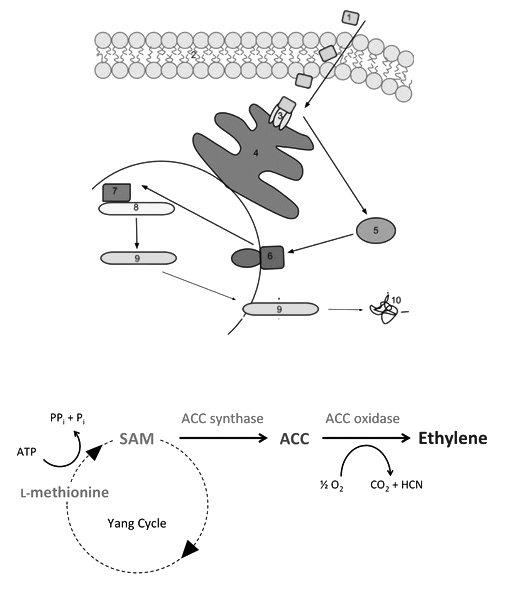Ethylene gas is a plant hormone that regulates plant growth, development and response to environmental stress. It is produced from leaves, roots, stems, flowers and especially ripened fruits. Like all hormones, ethylene functions via an intracellular signal transduction pathway, which is illustrated in Figure 1 above.
Figure 1. Signal transduction pathway of ethylene in plant cells. Key: 1. Ethylene Gas 2. Plasma Membrane 3. Receptor Protein 4. Endoplasmic Reticulum 5. Constitutive Triple Response Protein Kinase 1 (CTR1) 6. Ethylene Insensitive 2 protein (EIN2) 7. Ethylene Insensitive 3 protein (EIN3) 8. DNA 9. mRNA 10. Enzyme production
The biosynthesis of ethylene in plant cells occurs in a two-step biochemical pathway illustrated in Figure 2 below:
Figure 2. Ethylene biosynthesis starts when S-adenosyl-L-methionine (SAM) is converted to 1-aminocyclopropane-1-carboxylic acid (ACC) by the enzyme ACC synthase (ACS). ACC is then converted to ethylene by the enzyme ACC oxidase (ACO). The ACS and ACO genes are expressed in response to internal developmental cues and environmental stresses, such as wounding, flooding, drought, and pathogen attack.
The United States Department of Agriculture (USDA) estimates that farmers lose approximately 5% of their fresh fruit and vegetable stock due to spoilage, supermarkets lose an average of 10% and consumers lose an average of 30% (2005). It is, therefore, an economic necessity for the business and private sectors to control levels of ethylene around their fresh produce.
Of the methods described below, which one would not function to prevent the spoiling of fruits and vegetables during transport and storage?



 Get latest Exam Updates
Get latest Exam Updates 
 ×
×














